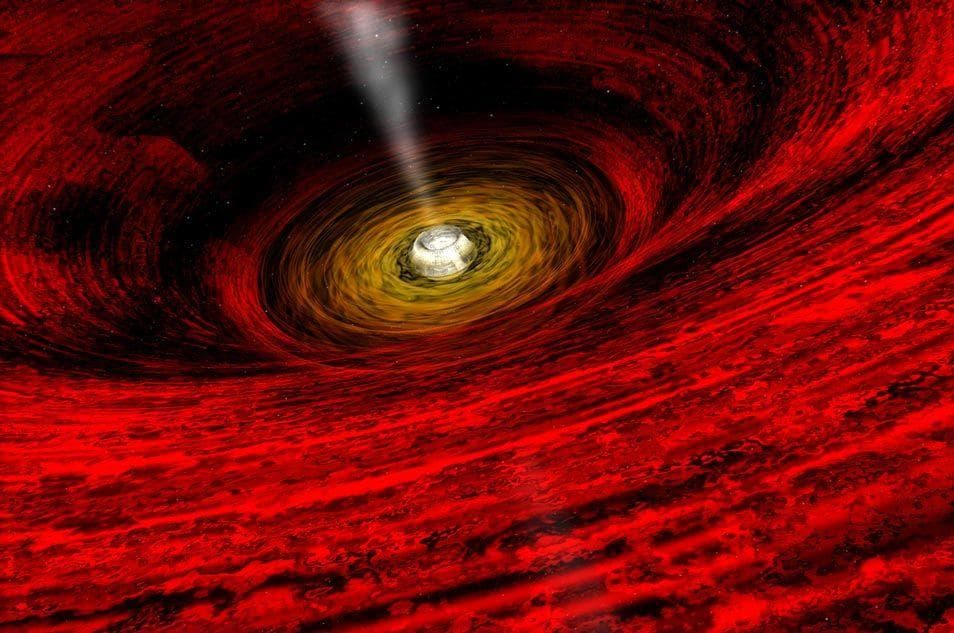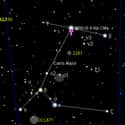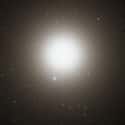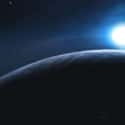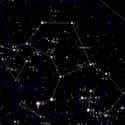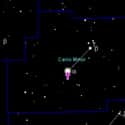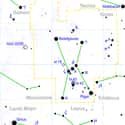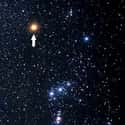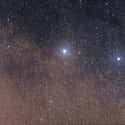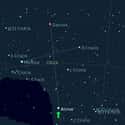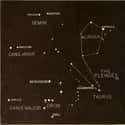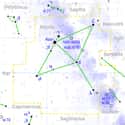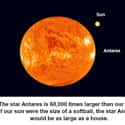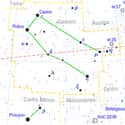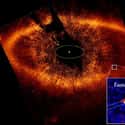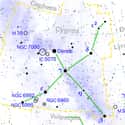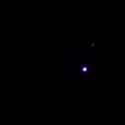-
(#1) Sirius
Magnitude: 1.46
In the constellation of Canus Major, Sirius is the brightest star in the night sky, outdistancing #2 on the list by twice as much. The star we see as Sirius was actually a binary star consisting of a white main sequence star (Sirius A) and a faint white dwarf companion (Sirius B). However, Sirius B went supernova, and while its remains help Sirius remain king of Bright, it's no longer two stars. It's bright because of both its luminosity and its proximity to Earth. Two times as massive as our sun and 25 times more luminous, the "Dog Star" is in a system that is between 200 and 300 million years old.
If you can't immediately find it by its brightness, just find Orion's belt and follow its line to the left to Sirius. You can't miss it. It also forms one point of the "Winter Triangle" with fellow mates, Procyon and Betelguese. -
(#2) Arcturus
Magnitude: -0.04
Found in the constellation Bootes, Arcturus looks a little orangey-yellow. It would actually be behind Alpha Centauri in brightness except for the fact that Alpha Centauri is actually two stars, and that wouldn't be fair. It's an orange giant, 110 times more luminous than our sun. Its mass is unknown, but thought to be only slightly larger than our sun.
An easy way to find it is to follow the arc of the Big Dipper's handle to Arcturus. -
(#3) Canopus
Magnitude: -0.72
This sparkler is in Carina. It is the brightest star in the Southern Hemisphere. Canopus is a "supergiant" spectral type F star that is 15,000 times more luminous than our sun and 65 times bigger. If you put it in the center of our solar system, it would extend three quarters of the way to Mercury. -
(#4) Vega
Magnitude: 0.03
In the constellation Lyra, Vega is the fifth brightest star in the sky and the second brightest in the Northern Hemisphere. It's also pretty close to earth at just 25 light years away. Scientists say it's the most important star in the sky, after our sun, precisely because of its proximity to earth and also because it is thought to have a planet, based on irregularities in its disk. Its only one tenth the age of our sun but it's 2.1 times as massive. You can see it in the Northern Hemisphere in the summer and, in fact, it is one of three stars (including Altair and Deneb) that make up the bright "Summer Triangle."
Follow the two stars of the Big Dipper that make up the back of the "cup." Go up, up, up in a straight line past Cassiopeia... and you can't miss it. -
(#5) Alpha Centauri
Magnitude: 1.33
You see Alpha Centauri as one star, but it's actually a binary system comprised of A and B. There's even a third star associated with the system called Proxima which is the closest star to our sun. If you have a telescope, you can actually see both stars, and they say that ancient Greek and Arab armies used to use its duality as an eye test for their men. This group of three stars is in the constellation Centaurus, and can only really be seen by folks in the Southern Hemisphere. -
(#6) Procyon
Magnitude: 0.34
Procyon is another point in the Winter Triangle (along with Betelguese and Sirius). It's in the constellation Canus Minor. You can see it just above Sirius, next to Orion. It's a white star, bright for its class, which suggests its going to start expanding "soon." Procyon is about 1.4 times the mass of our sun and 7.5 times more luminous. -
(#7) Rigel
Magnitude: 0.18
You have probably seen Rigel lots of times. It's in one of the most obvious constellations in the skies: Orion. It's the bright one that makes his foot - your right, his left. We don't know much about Rigel since it's so far away (between 700-900 light years). It's a blue supergiant that shines at about 85,000 times that of our sun. It's the most luminous star in our part of the Milky Way, so bright it lights up nearby dust clouds like the Witch Head Nebula. -
(#8) Betelgeuse
Magnitude: 0.42
Another star in Orion (he's got a lot of bright stars in and around him), Betelguese is a red supergiant. If you were to place it in the center of our solar system, it would extend past Jupiter! We don't know its mass for sure, because it's really far away... 640 light years. And, being a red supergiant, it's pretty much done for. Betelguese isn't expected to live past the next million years. -
(#10) Achernar
Magnitude: 0.50
Achernar is in the constellation Eridanus, a Southern Hemisphere star. Of the top ten brightest stars, it is the bluest. It burns 3,000 times brighter than our sun despite being classified as a dwarf star. Achernar is also the least spherical star in the Milky Way... spinning so rapidly that its equatorial diameter is more than 50% greater than its polar diameter. -
(#11) Alpha Crucis
Magnitude: 0.77
In the constellation Crux, Alpha Crucis is the southernmost 1st mag star. It is a multiple star, about 321 lights years away. Only two of its parts are visible - both are class B stars - with luminosities of 25,000 and 16,000 times that of our sun's. Also known as Acrux, it is represented in the flags of Australia, New Zealand, and Papua New Guinea. -
(#12) Capella
Magnitude: 0.76
In the constellation Auriga, Capella is actually a star system of four stars. The first two are large giant stars (each with a radius 10 times our sun's) in close orbit around each other, and are on their coolin' way to becoming red giants. The second pair are two small, faint red dwarfs. Put them all together and they make up the twelfth brightest star in the sky... only about 42 light years away. -
(#13) Altair
Magnitude: 0.77
Another of the three points in the Summer Triangle (along with Vega and Deneb), Altair is an A-Type Main Sequence star with about 1.8 times the mass of our sun and 11 times the luminosity. It resides in the constellation Aquila and it is one of the first and only stars for which a direct image has been retained (in 2006). -
(#14) Antares
Magnitude: 1.09
Part of the Scorpio constellation, Antares is a class M supergiant, about 800 times bigger than our sun. 600 light years away, it's about 10,000 times more visually luminous than old Sol, but because it radiates a huge part of its energy in infrared, its actually 65,000 times more luminous. -
(#15) Aldebaran
Magnitude: 0.95
An orange giant that lives about 65 light years away, Aldeberan is in the constellation Taurus. If you want to find it, go to Orion and follow his belt to the right. You will see the faint "V" of Taurus's head. Aldeberan is one of the points. It's red, you'll see it. (Another cool thing near Taurus and Aldeberan is the Pleiades - a foggy looking star cluster). Being an orange giant, Aldeberan has pretty much exhausted its hydrogen and is probably in the last long stage of its life. It has expanded to a diameter 44.2 times the diameter of the sun and it shines with 150 times the luminosity. -
(#16) Pollux
Magnitude: 1.15
Pollux is an orange giant that you can find in Gemini with another first magnitude star - Castor. This pair forms the "heavenly twins" that give Gemini its name. In 2006, a planet was discovered orbiting Pollux that is larger than Jupiter. Not so awesomely, some unimaginative scientist named this huge planet, not Gigantor or MegaWorld, but "Pollux B." Pollux is 34 light years from earth, so we won't be visiting Gigantor any time soon, plus... it's probably a pretty crappy place what with Pollux being pretty cold. -
(#17) Fomalhaut
Magnitude: 1.16
In the constellation Piscis Austrinus, Fomalhaut is another star in the Southern Hemisphere. Its about 25 light years away from earth, and it is believed to be a pretty young star - maybe only 100-300 million years old. Weirdly, it's metal-deficient when compared to our sun. Fomalhaut is also a member of the visible planet club. -
(#18) Deneb
Magnitude: 1.25
Deneb is the third member of the Summer Triangle. In the constellation Cygnus Deneb is a blue-white supergiant that is nearly 60,000 times more luminous than our sun. It is also the furthest 1st mag star from earth. Based on the little we know of Deneb, it appears to be about 220 times larger than our sun... and because of its high mass and temperature, it will probably have a short lifespan. -
(#19) Spica
Magnitude: 1.04
In the constellation Virgo, Spica forms the end of the stem of the skewed wine-glass shape of that zodiac sign. It's a blue giant, 260 light years from Earth and another binary star. Its two parts, however, orbit so closely that they cannot be seen as individual stars through a telescope. The primary star of the pair is about 10 times bigger than our sun and 12,000 times more luminous. -
(#20) Regulus
Magnitude: 1.35
Regulus is another star that you've probably seen more than you realize. It's pretty close to the Big Dipper, which tends to spend a lot of time in the sky, so if you just look right below it and see the backwards question mark, that's Leo. And in Leo, is Regulus. Regulus is a blue-white Main Sequence star that is 3.5 times the sun's mass. A young star, its only a few hundred million years old.
New Random Displays Display All By Ranking
About This Tool
Without other disturbances such as lights and pollution, people can see the countless stars and even the Milky Way on a clear sky. There are hundreds of billions of stars, and nebulae in the Milky Way and space, but not all the stars can be seen from the earth. Many people think that the sun is the brightest in space, that is a misunderstanding.
Mars is the only planet visible after night falls, Sirius is one of the brightest stars, you can easily find it in the winter sky of the northern hemisphere because it is relatively close to the earth. The random tool lists 20 brightest stars in the sky you should know.
Our data comes from Ranker, If you want to participate in the ranking of items displayed on this page, please click here.

